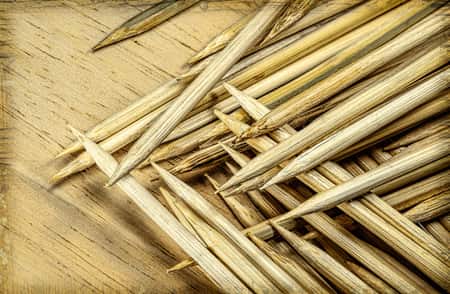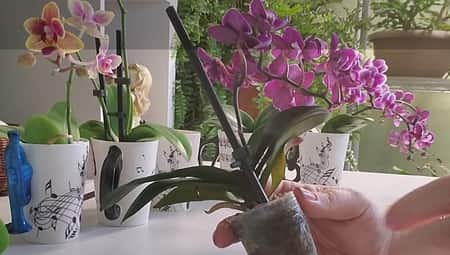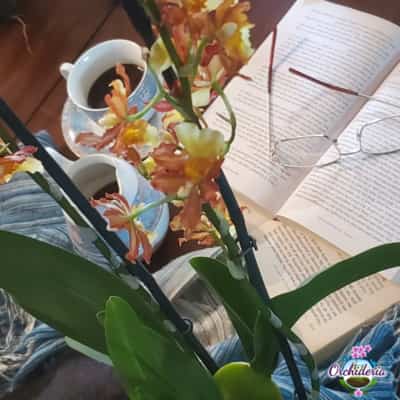Bamboo Skewers serve so many purposes than just the traditional barbecue. With orchid cultivating, you can diversify how you use bamboo skewers and really expand your knowledge and creatively inclement bamboo skewers in your hobby.
Four basic ways to use bamboo skewers in orchid cultivation is: (1) stabilizing an orchid with poor root system, making it secure in the pot, (2) Testing the water necessity of the orchids inside the potting medium, (3) add depth, height, and interest into floral designs without having to repot, (4) hand pollinating orchids, and (5) mounting orchid terrariums and vivariums.

Let’s dive into each one to see how they work.
1. Bamboo Skewers for Orchid Root Stabilization
The first way to use bamboo skewers on orchids is to stabilize the orchid. If you ever have bought an orchid, came home happily and excited, ready to repot, only to find out the orchid had root rot and hardly any roots?
How in the world are you going to keep this orchid crown out of the potting medium, yet keep the “roots” it in the potting medium enough so it doesn’t topple over, damaging the leaves, flowers, and pseudobulbs?
The best way to support your orchid is with bamboo skewers, where the stem can have the support, not being bumped or wiggled inside its pot. You can also use clips that are specific for this, but if the rootless orchid caught you by surprise,and you don’t have any on hand, use bamboo skewers.
There are several ways to do this.
Push the skewer into the potting medium as close as you can to the crown. Then use another skewer on the other side, again as close as you can to the middle. This supports the orchid upright, and won’t let it topple over. You’ll want to leave the skewers in the potting medium until the roots have developed enough to hold the pseudobulbs and crown upright.
Another way is to make four holes in the upper rim of your pot, as close as you can to the clock positions of 12, 3,6, and 9. With two skewers, crisscross the top of the plant, pushing it down into the potting medium. This ensures that the orchid has enough pressure to stand upright, yet is still in contact with the medium.
Image Credit: “purple orchids” by Kathy Drouin is licensed under CC BY-SA 2.0 

Either case, skewers are great because they are extremely cheap and can be changed often.
If you leave the skewer in the potting medium, it eventually will rot, so change them out whenever you see it’s accumulating too much humidity. This could be anywhere from two weeks to a month.
2. Bamboo Skewers to Test the Water Retention Level
The second way to use bamboo skewers on orchids is to test the water level. As new orchid growers, you’ll probably have a tendency to overwater. This can also happen to an experienced orchid grower who has acquired a new genus of orchid, yet still be “testing the waters.”
If you insert a bamboo skewer in the potting medium and wait a for thirty minutes before removing it, you have a very precise (as much as bamboo can be precise) reading of how much water is in the middle of your pot.
The top of the potting medium will dry out a lot faster than the middle will, and with bigger pots, it’s really hard to tell if the orchid needs to be watered.
There are some hints: if the pot is heavy, it still has water and you can wait a few days. If it’s light, the water has evaporated. Another way is to scratch the surface of the potting medium and test with your finger if the potting medium is humid. This works, but what’s the middle of the pot like?
The middle of the orchid pot will be the last to dry out.
By inserting the skewer right down the middle, you avoid the majority of the roots, which should be circulating the outer pot. Hardly any roots grow straight down. Also, the middle of the pot will be the most humid, since water will evaporate from the wholes in the sides of the pot.

It’s very easy to over-water an orchid thinking the middle of the pot is the same humidity as the exterior, but it isn’t.
The bigger the pot, the more this difference in water retention is seen. If you have a small pot, a miniature phalaenopsis, for example, the difference will be minimal.
But if you’re using a massive 8-inch pot, the middle is going to take longer to air out.
Most orchids don’t have deep roots. If you do have a massive eight-inch pot and the orchid is staying constantly wet on the inside but too dry closer to the sides of the pot, try using a bun pan.
This pan is wider than it is tall, and works well for orchids that need to dry out.
3. Bamboo Skewers for Orchid Floral Design
The third way is to create floral designs inside the orchid pot. Since most orchid designs you have to cut the flower spike off the orchid, I like to use the entire pot and create something amazing from there, keeping the spike intact.
I use this option more than I’d like to admit. I also have a really hard time just placing a big orchid pot on the table and saying, “There! It’s an orchid. Flower design complete!” I like to add at least a little something to jazz the pot up a bit.
Bamboo skewers are perfect for this, because you can create some really zen-looking designs with them.
For example, take two skewers and place them opposite of each other. Then hot-glue a third skewer across them both about ¾ the way up, with the ends sticking out a bit on each side. You now have a Japanese-looking decoration, for under 20 seconds of work.
The designs don’t hurt your orchid, add some dimension, and bring a more visually appealing style right to the orchid pot without much work.
Another great flower design is use 15 skewers, and push each one in the pot a little more than the previous. This makes a flowing wall effect, all while maintaining the potting medium intact and is easy, cheap, and fascinating to look at.
4. Bamboo Skewers for Hand Pollination of Orchids
The last way to use a bamboo skewer on orchids is for hand pollination. Some orchid growers use tweezers, or other utensils, but bamboo skewers work well, too.
I won’t go into the details of hand pollination here, first because I don’t have enough experience or expertise to write about that. Second, because this article  from home guides wraps it up pretty well.
from home guides wraps it up pretty well.
Since what I’ve read, is that once a flower is pollinated, it will wilt into itself, forming the seeds inside the wilted flower, I have no wish to do that.
Even though I could get seeds form this, I have no petri dish and no proper ways of carrying this pollination to completion.
I consider myself patient, but this is a whole new level. I’ll keep buying orchids the traditional way. 😊
5. Bamboo Skewers in Orchid Vivariums & Terrariums
Bamboo skewers are perfect for getting into those hard to get places and secure a plant into the substrate or medium. We traditionally think of potting medium, as in pots, but some people grow orchids in terrariums and vivariums.
A site I personally like is Josh’s Frogs , even though I don’t own an amphibian, reptile, or any moving creature of the sorts—at least not that I know of. Who knows what creepy crawlers inhabit my attic? Anyway, bamboo skewers are excellent for fixating orchids in the substrate and adding moss to hold them in place.
, even though I don’t own an amphibian, reptile, or any moving creature of the sorts—at least not that I know of. Who knows what creepy crawlers inhabit my attic? Anyway, bamboo skewers are excellent for fixating orchids in the substrate and adding moss to hold them in place.

I also won’t go into detail, because since Josh did such a great job at explaining this, I’ll leave it up to him.
It’s the second topic in his post, on how to plant epiphytes in a vivarium.
One of the most obvious ways that I didn’t even bother to mention in this article is to stabilize the flower spike. I did want to add it in as a special point because it was so obvious… But yeah, like in the picture, the bamboo skewers can stabilize the flower spike.
Don’t Stop Learning!
If you want to be included in more information and get a 14-page fertilization guide, please sign up for my newsletter. I don’t spam, but send emails out bi-monthly with some curious topics of interest. If you want more information, click here to go to a specific page on this website where I explain it more in detail.

Also, if you are looking for an orchid journal to keep your notes specifically about orchid care, check out my 2 solutions for that on this page. If note-keeping isn’t your thing, then there is a free excel spreadsheet that you can download. Click here for more information on how to do that.
If you subscribe to my newsletter, I will send you a 14-page guide on the main tips of orchid fertilizer. It is downloadable and you can print it out on your computer. I designed the guide to double up as a coloring book, just to make it fun.
These are just four ways to use bamboo skewers with orchids, but there are so many more. Use your creativity and start playing around with the skewers. You also find that there are many ways to use them in hanging baskets, in humidity trays, and simple orchid displays.
If you have pictures, post them in the comments below, and tell us how your orchid experiment with bamboo skewers went.
Happy Cultivating.

